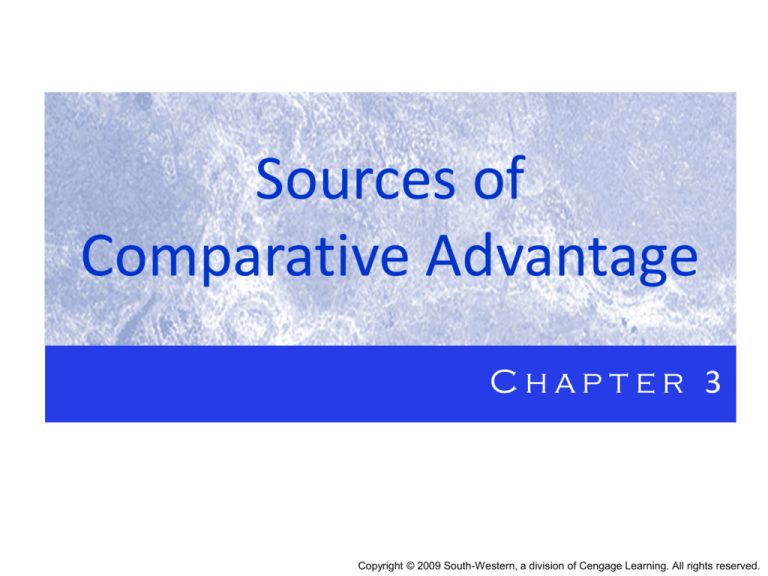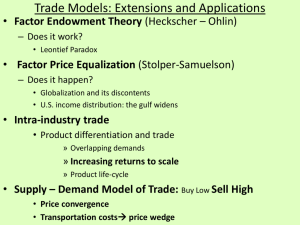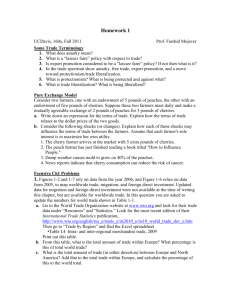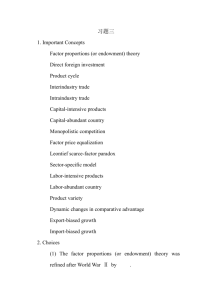
Sources of
Comparative Advantage
Chapter 3
Copyright © 2009 South-Western, a division of Cengage Learning. All rights reserved.
Factor Endowment Theory
economists Heckscher and Ohlin
o explanation of:
1) determinants of comparative advantage
2) impact of trade on earnings of factors
o nation will export goods which it produces with
resources that are relatively abundant
o nation will import goods which it produces with
resources that are relatively scarce
Factor Endowment - Example
o U.S.: capital/labor ratio = 0.5 (100/200)
o China: capital/labor ratio = 0.02 (20/1,000)
o Since the U.S. has relatively more abundant
capital, the U.S. will produce capital-intensive
goods with China producing goods that are
more labor-intensive.
Graphical Example
U.S. MRT = 0.33
China’s MRT = 4.0
implication is that U.S.
has a lower relative
price in aircraft
so U.S. has comparative
advantage in aircraft
& China has comparative
advantage in textiles
Graphical Example (cont.)
equilibrium at points B
and B where
slopes of PPCs are
equal
represents equal relative
price for each country
U.S. trades 6 aircraft to
China for 6 textiles
resulting in point C for
consumption
Implications of Factor Endowment
o U.S. - relatively abundant capital
China - relatively abundant labor
o expectation – U.S. produces capital intensive
goods and China produces labor intensive
o list of top exports confirm theory’s suggestions
Factor Price Equalization
o specialization causes U.S. to use more capital
and China to use more labor
o increases price of capital in U.S. and the price of
labor in China until factor costs are equal
Stolper-Samuelson Theory
o increased income for producers of goods
associated with relatively abundant resources
o decreased income for producers of goods
associated with relatively scarce resources
o magnification effect – change in price of the
resource is greater than the change in the price
of the good produced with that resource
o implication: overall, free trade provides gains
to a nation but specifically some parties gain
while others lose
Specific Factor Theory
o previous models assumed all resources were
completely mobile within a country
o in actuality specific factors may exist that
cannot move easily from one industry to another
o specific factor theory analyzes short run
income distribution effects in contrast to previous
theories focused on long term results assuming
resource mobility among industries
o conclusion: trade causes losses for resources
specific to import-competing industries and gains
for resources specific to export industries
Leontief Paradox
o Leontief tested validity of factor endowment
theory using 1947 data on capital to labor ratios
o results: ratio lower for U.S. export industries
than for import-competing industries
o contrary to factor endowment theory
o repeated using 1951 data – similar results
Trade & Income Inequality
S0
Wage Ratio
o wage ratio = wage of
skilled workers divided
by wage of unskilled
workers
o labor ratio = quantity
of skilled workers
divided by the quantity
of unskilled workers
o supply and demand
will determine wage
ratio and thus the level
of income inequality
2.0
D0
2.0
Labor Ratio
Technological Change
S0
2.5
Wage Ratio
o free trade, decreased
transportation costs,
and skill biased
technology increase the
demand for skilled
workers in relation to
unskilled workers
o result is an increase
in the wage ratio
o promotes a greater
degree of income
inequality
2.0
D1
D0
2.0
Labor Ratio
Immigration
S2
S0
2.5
Wage Ratio
o increase in unskilled
workers decreases the
supply of skilled
workers in relation to
unskilled workers
o result is an increase
in the wage ratio
o again promotes a
greater degree of
income inequality
2.0
D0
1.5
2.0
Labor Ratio
Education and Training
S0
Wage Ratio
o increased education
and training lead to an
increase in the supply
of skilled workers in
relation to unskilled
workers
o result is a decrease in
the wage ratio
o reduces income
inequality in this case
S1
2.0
1.5
D0
2.0
Labor Ratio
2.5
Increasing Returns to Scale
o increasing returns to scale also known as
economies of scale imply lower costs per unit at
higher levels of output
o increasing returns theory – despite limited
comparative advantage trade can be beneficial if
trade leads to lower cost per unit associated with
economies of scale
o home market effect – countries will specialize
in goods with large domestic demand since
proximity will reduce transportation costs
Theory of Overlapping Demands
economist Staffan Linder
o firms produce goods with large domestic demand
and these goods are potential exports
o export potential to countries with consumer
tastes similar to domestic market
o consumers conditioned by their income levels
high income – demand higher quality goods; luxuries
low income – demand lower quality goods; necessities
o limited trade in goods between wealthy and poor
nations because of limited overlap of demand
Intraindustry Trade
o industrialized nations have practiced
intraindustry specialization – focus on particular
products within a given industry
o 2006 data contradicts Ricardo and HeckscherOhlin
Intraindustry Trade (cont.)
Reasons for trade - homogeneous goods
o lower transportation costs near borders
o seasonal variations may impact both supply and
demand
Reasons for trade - differentiated goods
o demand of the ‘minority’ consumers not met by
domestic producers
o overlapping demand segments
o economies of scale associated with greater
output of a specific type of good
Product Life Cycle Theory
goods undergo a predictable trade cycle shifting
from export to import over the following stages:
1)
2)
3)
4)
5)
introduction of good in home market
domestic industry exports
foreign production begins
domestic industry loses comparative advantage
imports become more likely
implications:
• gains from trade are based on technological innovation
and spread of that innovation to other countries
• continual innovation needed to remain competitive
Dynamic Comparative Advantage
o Ricardo’s analysis was static assuming that
comparative advantage did not change.
o In actuality, comparative advantage can and
does change over time.
o Industrial policy refers to government
attempts to change or create comparative
advantage.
o Such policy is used to stimulate industries with
high productivity, economic significance, and a
possibility of long term growth.
Government Regulation
o Free trade leads to equal prices in the U.S. and
South Korea.
o South Korea exports 4 tons to the U.S.
Government Regulation (cont.)
o increase in U.S. environmental regulation
increases costs and decreases supply
o leads to higher prices and more exports from
South Korea to the U.S.
Transportation Costs
o free trade will
cause the U.S. to
produce more autos
and Canada to
produce fewer until
the prices are equal
o U.S. will export
autos to Canada and
the price will be
$6,000 in both
markets
Transportation Costs (cont.)
o transportation
costs will increase
the price to $7,000
in Canada
o Canada will import
fewer autos from the
U.S. as a result of
higher price
o U.S. price falls to
$5,000 as a result of
fewer exports and
lesser demand











